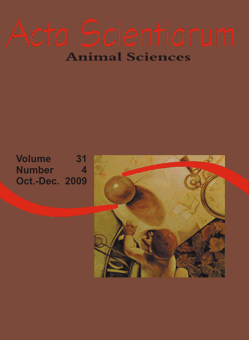<b>Organic selenium in the diet of Nile tilapia (<em>Oreochromis niloticus</em>) broodstock</b> - DOI: 10.4025/actascianimsci.v31i4.6300
Keywords:
minerals, nutrition, broodstock, culture tilapia
Abstract
The aim of this study to test the effect of organic selenium supplementation in the diets of Nile tilapia broodstock. Growth, reproductive performance and performance of fingerlings were evaluated. Eighty adult fish were used, with average weight of 121.7 g and divided into groups of four animals (3 female and 1 male) stocked in 20 tanks with 1.5 cubic meters. The fish were fed five diets containing different levels of organic selenium (0.0, 0.25, 0.50, 0.75, and 1.0 mg kg-1 ration). In the experimental period, females from all tanks were captured and the eggs collected. The experimental design was entirely randomized, with five treatments and four replicates. To evaluate progeny performance, the fingerlings were shared in four aquariums and fed during 30 days with commercial diet (45% CP). The supplementation with organic selenium did not affect the productive performance as with the reproductive parameters of the broodstock (p > 0.05). On the other hand, the broodstock fed with 0.50 mg of organic selenium produced fingerlings that presented improved weight gain (p < 0.05) compared to fish fed the control diet.Downloads
Download data is not yet available.
Published
2009-11-04
How to Cite
Pereira, T. S., Fabregat, T. E. H. P., Fernandes, J. B. K., Boscolo, C. N., Castillo, J. D. A., & Koberstein, T. C. R. D. (2009). <b>Organic selenium in the diet of Nile tilapia (<em>Oreochromis niloticus</em>) broodstock</b> - DOI: 10.4025/actascianimsci.v31i4.6300. Acta Scientiarum. Animal Sciences, 31(4), 433-437. https://doi.org/10.4025/actascianimsci.v31i4.6300
Issue
Section
Animal Production
DECLARATION OF ORIGINALITY AND COPYRIGHTS
- I Declare that current article is original and has not been submitted for publication, in part or in whole, to any other national or international journal.
The copyrights belong exclusively to the authors. Published content is licensed under Creative Commons Attribution 4.0 (CC BY 4.0) guidelines, which allows sharing (copy and distribution of the material in any medium or format) and adaptation (remix, transform, and build upon the material) for any purpose, even commercially, under the terms of attribution.
Read this link for further information on how to use CC BY 4.0 properly.
0.9
2019CiteScore
29th percentile
Powered by 








































